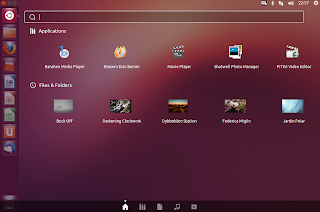Note this is part of a series of posts debating which is the best GNU/Linux distributions for desktop users.
Popular & Polished
Ubuntu is the most popular and the most polished GNU/Linux distribution for desktop users.Many competing distributions are anywhere from half a week to half a year behind. Ubuntu releases new versions on faster schedule than other GNU/Linux distributions and on a much faster schedule than Microsoft Windows or Mac OS X.
It's hard to get accurate statistics on operating system installations, in part because Microsoft has relationships with many hardware vendors that require them to pre-install Microsoft Windows on machines even if those machines wind up running Ubuntu or another flavor of GNU/Linux.
Canonical, the company behind Ubuntu, is partnering with more and more hardware companies. In China and Africa in particular, hardware companies are preinstalling Ubuntu (instead of Microsoft Windows) on increasing numbers of computers.
The Ubuntu Logo
The Ubuntu logo is a circle of friends: three people with arms around the shoulders of the other, viewed from top. And that's the spirit of the Ubuntu distribution and the community that's been built around the product.Ubuntu Screenshots
 |
| Ubuntu's Unity Desktop |
 |
| Unity's Dash |
Ubuntu Features
The Ubuntu Dash is the program launcher inside of Ubuntu's Unity window manager. The Dash darkens rest of desktop and allows you to select or browse for your program. You can start typing the name of the program you're looking for and it will pop up.You can invoke the Dash by clicking the Ubuntu icon in the upper left corner of the screen or by hitting the 'Super' key on your keyboard.
If you don't like the Ubuntu Dash, you can add back the Classic Menu Indicator, which is like a traditional 'Start' menu where you can browse for programs through a hierarchy.
Another interesting feature of Ubuntu's Unity is the HUD (Heads Up Display). The HUD allows you type a command that may be embedded within a program (e.g. crop within GIMP) and go right to that program function. The technology is still new and may need to evolve some more before most users find it beneficial.
CTRL-Alt-T opens a terminal window in Ubuntu and there are many other keyboard shortcuts that speed up regular activities.
The Ubuntu Software Center is another great Ubuntu feature. It allows you to quickly and easily find new software, including free and open source software (FOSS), in manner similar to an app store. The great thing about FOSS options are that they are free, both in the sense of respecting your liberty and not lightening your wallet
Unity and Alternative Choices with Ubuntu
Ubuntu's Unity window manager was met with controversy when it was first released. Similar to the reaction some users have had to the shift in paradigm that GNOME took when the moved from GNOME 2 to GNOME 3, many loyal Ubuntu users found Unity to be too radically different front prior windowing conventions when it was first released.Some of the negative reaction may have been due to roughness around the edges, which Unity was guilty of when it was first released with Ubuntu 11.04. But now, Ubuntu is on version 12.10 and offers a much more polished experience.
If Unity still isn't the right window manager for you, no need to despair. Ubuntu offers the option of using a myriad of other options for window managers, including KDE, XFCE LXDE and others. If you install these alternate window managers, you'll be able to select you preferred window manager each time you log into Ubuntu. What can be more flexible than that?
A Community of Support
Ubuntu's popularity means that if you have a question, there is a greater pool of users with potential answers. Further, Ubuntu has rich online communities and resources including:Ask Ubuntu
Official Ubuntu Documentation
Download Ubuntu & Try It
Like with many other GNU/Linux distributions, you can download Ubuntu for free and create a Live DVD or thumbdrive that can used to install the operating system. I say "live" because when you boot from the DVD or thumbdrive, you can actually run the operating system directly and try it out, without needing to install it or changing anything on your harddrive.If you do install Ubuntu, the installer makes it easy to install it along side an existing operating system such has Microsoft Windows. That way, if you still want access to your old operating system, it won't be wiped out by the install. If this option is chosen, a boot loader program will be installed and it will allow you to choose which operating system to boot into each time your computer starts up.
Get Ubuntu here:
http://www.ubuntu.com/


Amazing
ReplyDeleteI have been a keen user of the program but with the passage of time the choices change due to change in the Source and I shifted to some option as well to gain the maximum out of available sources.
ReplyDelete